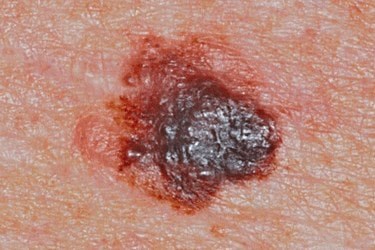Skin conditions aren’t always easy to decipher. Many benign skin growths can show up anywhere on the body. The good news is that skin tags are easy to identify. You can tell them apart from a melanoma and other malignant conditions relatively quickly when you know the signs.
Unless a skin tag is infected, it’s just a cosmetic issue. But, if you’re unsure how to identify a specific condition, some skin growths can become a major medical problem. So, it’s no surprise that you may be finding it hard to tell the difference between a skin tag and melanoma.
It’s fundamental to an accurate diagnosis. Once you know what to look for, you’ll be able to distinguish between a benign skin growth, like a skin tag and a malignant growth, like a melanoma.
This article will enable you to understand the differences between these two skin conditions. But if you’re unable to make an accurate diagnosis or have further dermatological concerns, we’d strongly recommended that you get the expert opinion of a doctor without delay.
How to Correctly Identify a Skin Tag
Skin Tags are believed to be caused by friction. That’s why they tend to appear on the neck, under the arms, groin, and eyelids. There are other potential causes, not limited to hormones, pregnancy, weight gain, and genetics. The causes of skin tags are often linked together.
Here are the characteristics of a skin tag:
- Acrochordons are soft and fleshy growths.
- Usually small, but they can grow to the size of a grape.
- They are attached to the skin by a narrow stalk or peduncle.
- Normally the same color as your skin but they can be darker.
- Not an immediate source of pain or discomfort.
- Unlike warts or genital warts, they aren’t contagious.
Do Black Skin Tags Mean That I Have Cancer?
You may have noticed that a black skin tag has appeared overnight. This usually happens when it has become twisted so that no oxygen can reach it. It is in a thrombosed state and will usually fall off on its own in approximately 2 to 3 weeks.
If this doesn’t happen, you should get it checked by a dermatologist. If they think that there’s a problem or can’t accurately diagnose the condition, they’ll perform a biopsy. It’ll then be sent to a laboratory for extensive testing. Genuine medical issues are covered by health insurance.
Twisting and pulling at skin tags on the body is inadvisable because it can lead to irritation. This can lead to other unpleasant skin conditions that can become confused with skin cancer. More commonly, it leads to more visible blood-filled or red skin tags.
What Are the Symptoms of a Melanoma?
A melanoma is different to a skin tag. While a skin tag is harmless, a melanoma is a cancerous condition that has implications for your long-term health. More often than not people associate a melanoma with a mole, which is another type of benign skin condition.
The symptoms of a melanoma include:
- A sudden new growth on the skin.
- Unusual size changes to an existing growth.
- A change in an existing mole or growth.
- Darkening of the skin.
- Growths with an irregular border.
When you get a mole, it is caused by cells that produce pigmentation. Moles are just a cluster of these cells on the surface of the skin. If they become cancerous, the signs start to become visible.
Treatment Options for Skin Tags
Skin tags don’t need to be treated. You only need to remove skin tags if they become bothersome or you don’t like the way they look. Removal with a TagBand tool or Australian Apothecary tea tree oil is incredibly easy. No method works for everyone, but both of these work well.
Never attempt to remove an infected skin tag. Wait until the infection has cleared up or use a cream from a doctor or pharmacy to heal faster.
Treatment Options for a Melanoma
Treating a melanoma is more difficult, and early detection is essential to a successful outcome. So, keep a close eye on any growths that appear on your body. If there are any sudden changes to your skin, seek the professional opinion of a dermatologist immediately.
Treatment for a cancerous melanoma can include one or a combination of the following:
- Radiation therapy
- Imiquimod cream (Zyclara)
- Targeted therapy
- Immunotherapy
- Surgery or wide excision
- Chemotherapy
- Biochemotherapy (chemotherapy and immunotherapy)

Steps must be taken to kill the cancerous cells and remove the disease from your body. A melanoma should be taken very seriously and treated as early as possible. When a melanoma is caught at an early stage, the treatment will need to be less invasive.
Find out more info on treatments at different stages here: http://www.cancer.org/cancer/skincancer-melanoma/detailedguide/melanoma-skin-cancer-treating-by-stage
Monitor the Differences in Skin Conditions
It can sometimes be difficult to see a skin growth on less visible parts of the body. And that can make it easy for a melanoma to go unnoticed. Search your body for unusual lumps at least once a month. Early detection is critically important if you do have a form of skin cancer.
If you find any new growths or that an existing one has changed take some time to examine them more closely. Whether you have a skin tag or melanoma, you’ll have peace of mind in knowing that you found it within weeks. If necessary, your doctor can then correct the problem.
